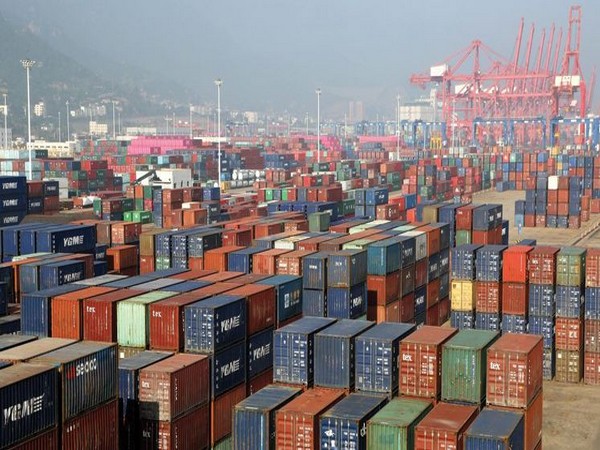
New Delhi: Since India opened its markets in 1991, there has been an exponential rise in the country’s foreign trade which has made a significant contribution to its economic growth.
With the historic make in India campaign and implementation of GST, in the past 9 years itself, India’s overall trade has witnessed an increase of 65% (from $1,001 billion in 2013-14 to more USD 1662 billion in 2022-23). India’s overall trade is approximately 48 per cent of India’s nominal GDP at USD 3.4 trillion in 2022-23. A close look at India’s trade performance (merchandise and services combined) exhibits a bright picture of growth, continuity and security that instills trust among foreign investors for establishment of their GVCs.
India’s trade (combined merchandise and services) from FY 2011 to FY 2023 shows the rising trend over the years while being impacted during the turbulent years. India’s trade was, however, quick to respond and it regained its momentum after every difficult year. In 2015-16, India’s trade saw a decline owing to the global slowdown; however, the trade recovered in 2016-17 with the resilience of India’s value chains.
India’s trade witnessed a decline during the disruption caused by the COVID-19 pandemic during the years 2019-20 and 2019-2020. However, India’s robust and resilient value chains regained momentum and showed a rise in the trade at 41.6% in 2020-21 reiterating the robustness and resilience of its value chains.
India’s export volume (combined merchandise and services) from FY2011 to FY 2023 also remains robust. India’s exports increased 105% from USD 375billion in 2010-11 to USD 770 billion in 2022-23. Though the exports trajectory was impacted by Covid-19 pandemic, however, it recovered significantly in the post pandemic years with the support of conducive business environment and ease of doing exports created by the Government.
During this period two foreign trade policies were launched in 2015 and 2023. India's previous Foreign Trade Policy (FTP) was for five years from 2015-2020 but first due to the pandemic and later due to Ukraine war, it was not revised and the government decided to proceed with it until the end of March2023.
On 31 March 2023, the Union Minister for Commerce and Industry announced FTP 2023 with a vision to bring a manifold increase to India’s exports. With FTP 2023 in place, the government has set an ambitious target of India’s exports worth $2 trillion by 2030 of which $1 trillion will come from merchandise and USD1 trillion from services exports. FTP 2015-20 contributed significantly to the growth of India’s export in merchandise and service. Exports increased from $416.8 billion in the FY2016 to $670 billion in the FY2022, and have increased to $770 billion in FY2023.
India’s top 25 export destinations
An analysis of India’s top 25 export destinations reveals that India’s exports grew more than 20% with 7 countries during the last 5 years (average). The growth rate of India’s top 25 export destinations from FY2019 to FY2023 has been calculated. The 5 years average from FY 2018-19 to FY 2022-23 has been considered to remove the fluctuations, if any due to some reasons.
Analysis shows that our exports grew more than 20% (average) yearly to Togo, Netherlands, Brazil, Israel, Indonesia, Turkey and Australia followed by 10% to 19% with USA, South Africa, Saudi Arabia, Belgium, Italy, Korea, Bangladesh, Thailand and France. Exports grew 4% to 8% with UAE, Nepal, Malaysia, China, Singapore, UK and Germany. However, exports to Vietnam and Hong Kong posted a negative growth.
Going ahead, the GDP growth of top ten growth oriented destinations including Togo, Netherlands, Brazil, Israel, Indonesia, Turkey, Australia, South Africa, Saudi Arabia and Belgium has been analyzed to check the demand trajectory of these economies. According to the IMF data, the growth is seen decelerating in these economies from 4.8% (average) in 2022 to 2.3% in 2023. However, GDP growth of these economies will pick up to steady zone at 2.8% in 2024 and 2025. This indicates that slowdown in exports in the current year 2023 is expected to pick up in 2024 and 2025.
Many of India’s top ten highly growing export destinations will be witnessing an increase in the real GDP growth in 2024 and 2025 that will have positive impact on India’ exports to rejuvenate once again at to make new highs in the coming years 2024 and 2025.
The growth of services during the last two years at 24% is commendable as services have shown a great resilience and price competitiveness in the global markets. Services exports’ impressive growth despite the global slowdown can be attributed to the greater use of technology across industries during the lockdown which has intensified subsequently.
The growth in Artificial Intelligence (AI) and Machine Learning (ML) has increased services demand. Services exports will play a vital role in controlling the current account deficit. The growth of services exports will, hence, become a major growth driver to achieve the ambitious targets of USD 2 trillion by 2029-30.
With an aim to boost India’s export performance, a dynamic and responsive Foreign Trade Policy 2023 has been launched on 31 March 2023. The policy aims to meet the emerging trade scenario by taking advantage of India’s federal system.
As a way-forward, the new FTP 2023 aims to involve wider engagement with states and districts to promote exports from the grassroots to develop each state for India to be able to integrate with the global trade.
The new Foreign Trade Policy (FTP) 2023 with its five key elements of Duration, Dynamism, Decentralisation, Direction and Disaster proofing, is aimed at creating an enabling ecosystem for exporters.
The FTP 2023 aims at collectively increasing India’s competitiveness in the global markets by promoting and developing each state to be able to integrate with the global trade which is a move in line with India’s vision of becoming “Atmanirbhar” (self-reliant). Overall, ease of doing exports with calibrated reforms by the government will be crucial to achieve the target of USD 2 trillion by 2030.